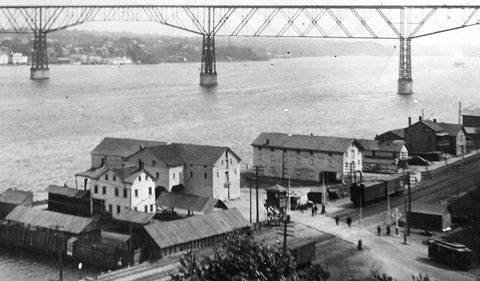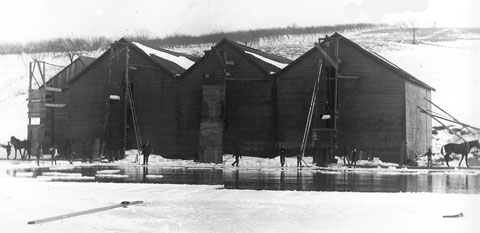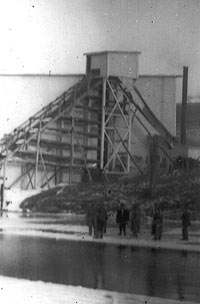Winter Tale: The Horse Shoe
Winter 2009
 “Your grandfather cut ice at Mohonk.” My father spoke the words without preamble or explanation as we walked along the outside of a huge stone foundation in glorious Fall weather. I knew my grandfather (Louis Yess I) worked, as most subsistence farmers in the area had, doing anything—lumbering, field clearing, hauling, machine repair, construction, fishing, and a multitude of other “cash jobs”—when their own harvest was completed. Though news to me, it did make sense that Mohonk and all the big resorts would have had their own icehouses. It just never occurred to me that my grandfather had been one of the ice harvesters for a resort.
“Your grandfather cut ice at Mohonk.” My father spoke the words without preamble or explanation as we walked along the outside of a huge stone foundation in glorious Fall weather. I knew my grandfather (Louis Yess I) worked, as most subsistence farmers in the area had, doing anything—lumbering, field clearing, hauling, machine repair, construction, fishing, and a multitude of other “cash jobs”—when their own harvest was completed. Though news to me, it did make sense that Mohonk and all the big resorts would have had their own icehouses. It just never occurred to me that my grandfather had been one of the ice harvesters for a resort.

Highland Landing 1912, note trolley on right side of photo. Warehouses, docks, offices, stations. A very busy place.
Photo Town of Lloyd Historian’s collection
The thought of traveling in winter from his farm in Esopus up the mountain by the conveyances available then, seemed unlikely. Walk four miles to the New Paltz Road and take the trolley that ran between Highland Landing and downtown New Paltz. Then take one of Mohonk’s carriages up the mountain? I think not. Or take his own horse and wagon the whole way? Did he have a car? Maybe other ice cutters picked him up in a truck or car? No idea. And now, there is no one to ask.
There had been a very large farm on a lake north of ours where my grandfather had cut ice. That ice was used to store the farm’s produce, milk, eggs and currents. Among all the idle “treasures” strewn about our home, we had a specialized cleat-studded shoe an ice harvesting horse wore to walk out on the frozen lake.

1906 photo of a Hudson River ice house complex with ice cutting taking place in the foreground.
Photo by Henry Reichert and used with permission of Town of Lloyd Historian’s Office
The talk of ice cutting had been stirred in my father’s memory because the football-field size foundation beside us that day was from one of the dozens of icehouses along the Hudson River. The insulation of these behemoth buildings was saw dust, “good insulation, and combustible as all get out,” my father said.

Icehouse elevator and workers at Schantz’ Pond, Highland, 1906.
Photo from collection of John Valentino at Lloyd Town Historian’s office.
A number of the buildings burned, and the survivors went the way of the ice box—outmoded by technology. I remember riding with my other grandparents to an icehouse in Milton to restock their ice box.
I emptied the drip tray of melted ice from it—the metallic smell of the ice box and drip tray fill my mind as I write this, though that job was performed almost 60 years ago.
My ice-cutting grandfather died before I was born. I often think of what he must have been like. Hard working for sure. And then I think about the soft life all my forebears’ efforts created for me. Immigrating across restive oceans, farming for others, farming for themselves, and working, relentlessly working. And saving everything—a horse shoe with cleats—because “you never knew” what would be useful down the road… or the decades.
